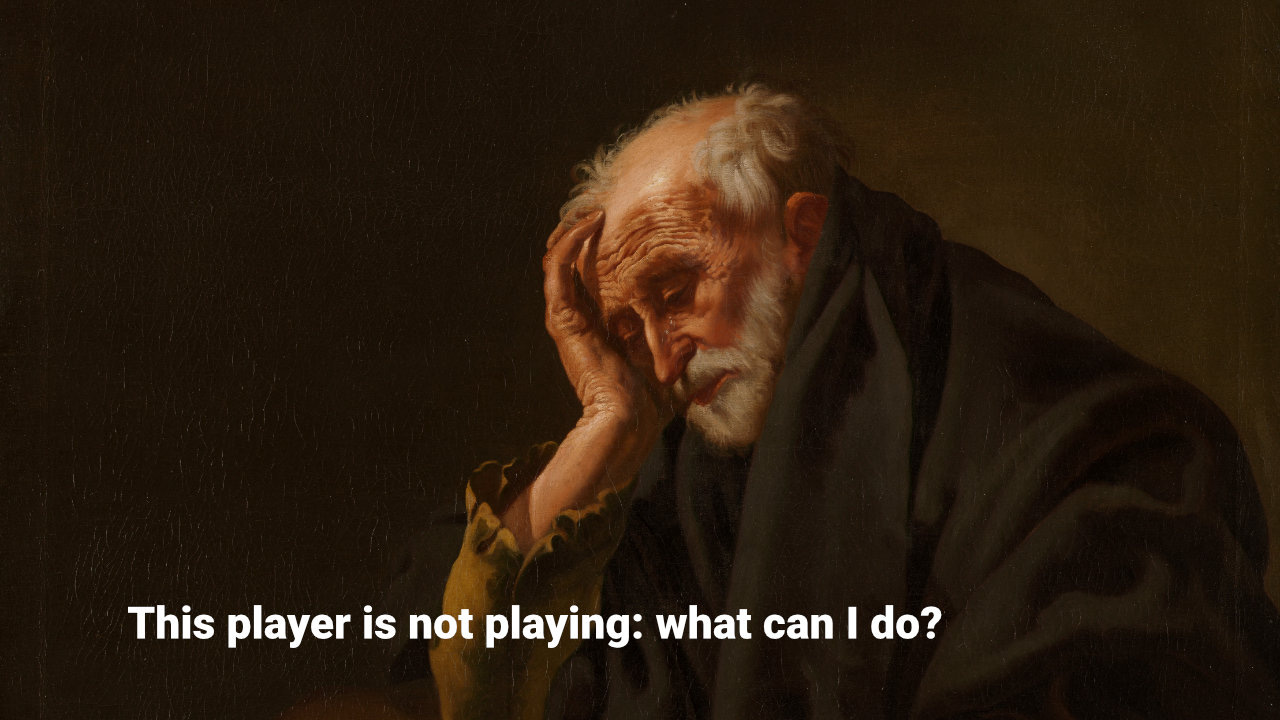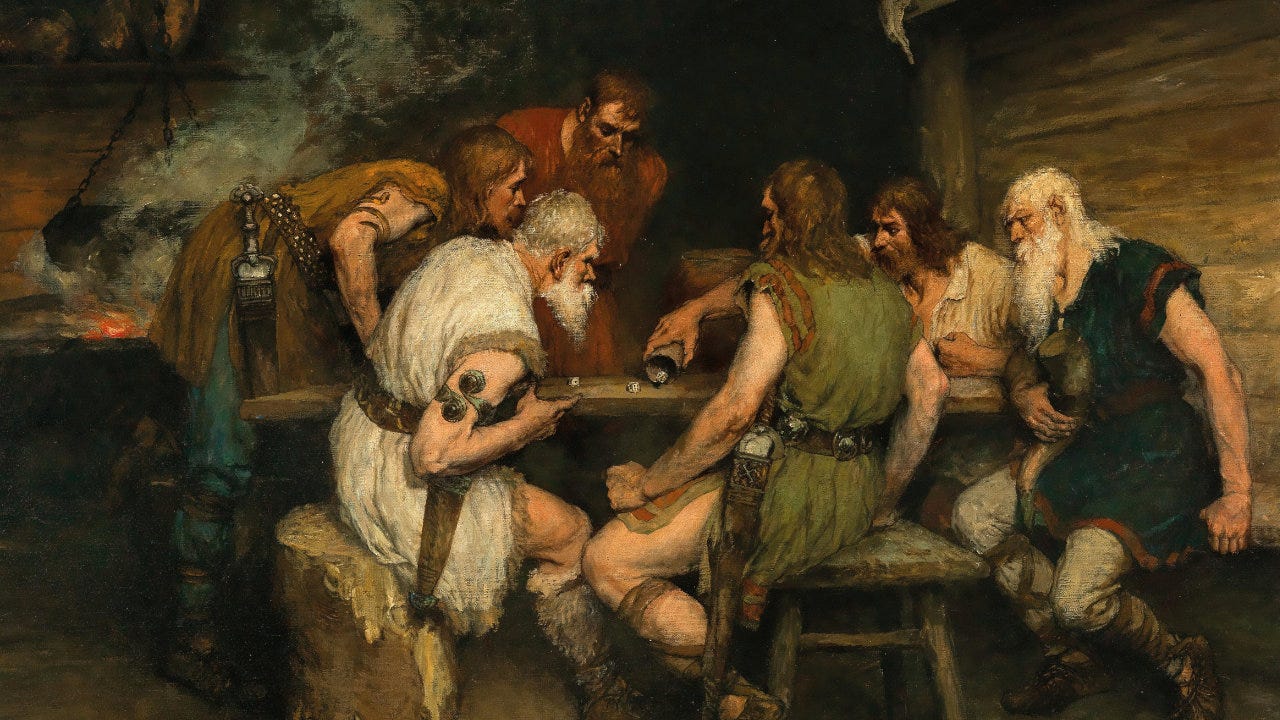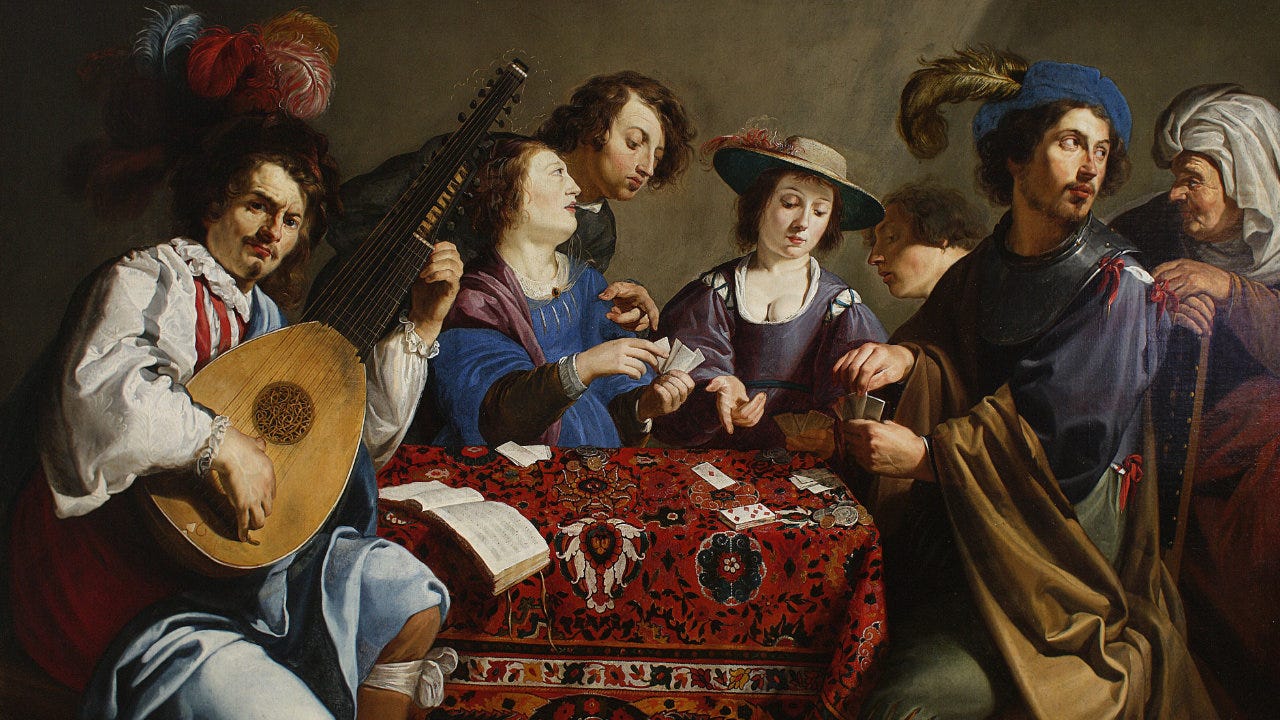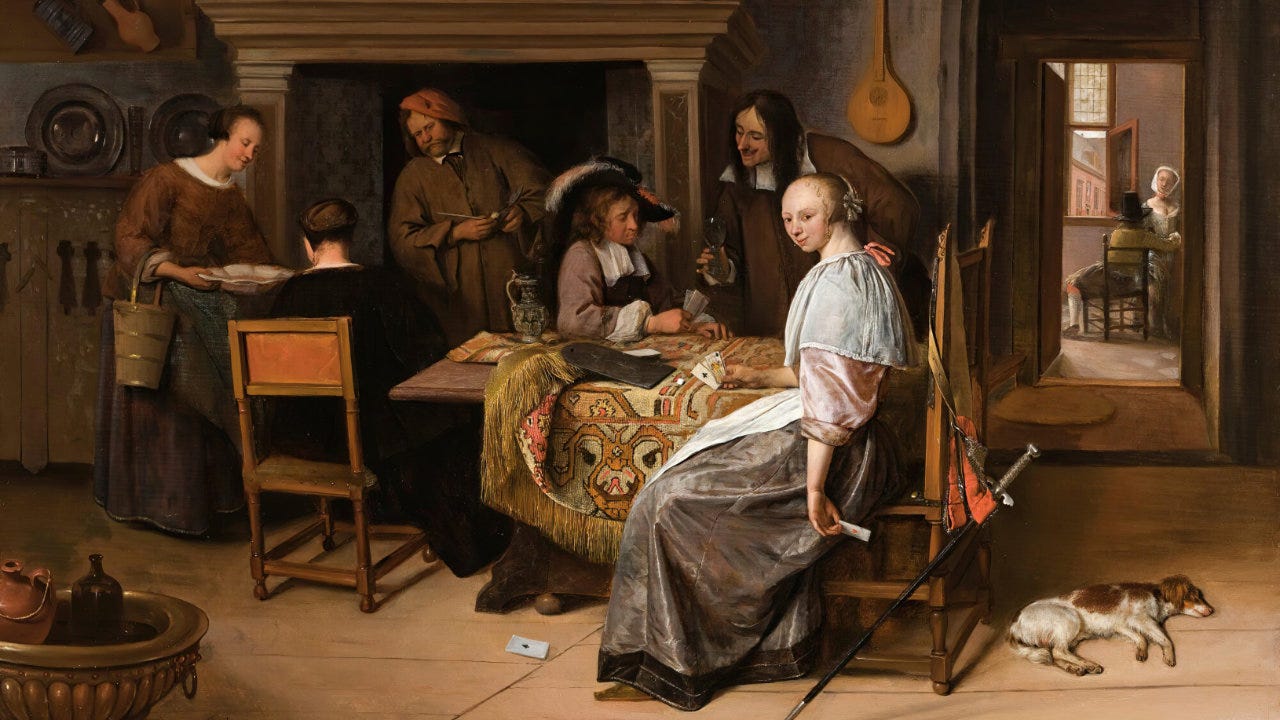This player is not playing: what can I do?
Tips for designing games that inherently reduce analysis paralysis (AP) during play
Welcome to Skeleton Code Machine, an ENNIE-nominated and award-winning weekly publication that explores tabletop game mechanisms. Check out Public Domain Art and Fragile Games to get started. Subscribe to TUMULUS to get more design inspiration delivered to your door each quarter!
You’ll immediately know today’s topic based on the title if you’ve played a board game on BGA. Take too long to finish your turn, and the dreaded message appears to other players: This player is not playing: what can I do?1
But first, a few important updates:
📝 Let me know what you think: Take the Skeleton Code Machine Annual Reader Survey if you haven’t already! It’s open until December 31, 2024.
🏆 Nominate your favorite blogs: Use the Bloggies 2024 nomination form to nominate your favorite TTRPG-related blog posts published between December 1, 2023 and November 30, 2024.2
📦 TUMULUS shipping: Although I placed the print order back in November, the printer notified me that the first issue of TUMULUS wont be dispatched (to me) until this week. All extras (e.g. art prints, stickers) have arrived and are ready to go. Watch Exeunt Omnes for additional updates.
Now, back to what you can do about (or for) slow players…
Analysis paralysis
You want to make the most of your limited turns or actions in a game. It could be squeezing out the most efficiency in Vital Lacerda’s latest euro, or trying to make the most of your limited spells in a TTRPG. Making the wrong choice might have significant consequences, so you run through the options. You map out how each choice might affect later decisions. Other players stare at you, awaiting your decisions. Time passes. Someone politely asks, “Who’s turn is it?”
This is called analysis paralysis (AP) and it can happen to the best of us.3
AP is when a player becomes stuck during a game, overthinking their actions and overwhelmed by the number of options available. Afraid of making a suboptimal choice, they take longer than appropriate to decide. This slows down the game and may disrupt the flow of play for everyone at the table.
There are many reasons an individual player might be inclined to take “too long” during their turn. It’s easy to find advice for players on how to get over their personal AP struggles. But I’d like to explore the topic from a different angle: How can designers make games that are less likely to trigger analysis paralysis in players?
How to design an AP-resistant game
Ultimately, the amount of AP experienced at the table depends on the players as much as it does the game’s design. There are things a designer can do, however, to help players experience AP a little less. Here are five that apply just as much to board games as they do tabletop roleplaying games:
1. Limit the decision space
Reduce available actions: There are over 60 action spaces in A Feast for Odin (Rosenberg, 2016), which can lead to some significant AP in new players. One way to counter this is to limit the decision space by reducing the available actions. Reiner Knizia is an expert at this, often giving players a choice of just one or two actions on a given turn and yet still providing strategic depth. Cascadero (Knizia, 2024) is a recent example where players ostensibly only do one action on their turn: place a envoy on the hex map.4
Use hidden information: While it might seem like giving players more information would make their decision easier, that’s often not the case (e.g. the reason chess has timers). Hiding individual player endgame victory points like in Troyes (Dujardin, Georges, et al., 2010) reduces the need to focus on other players. Information can also be “hidden” behind the randomness of dice or cards, effectively reducing inputs to the player’s decision making.
2. Short-term goals and incremental progress
Smaller victory point (VP) gains: Rather than players getting a lot of VP for single achievements, spread it out across many places in the game (e.g. point salads). Being able to at least get a few points no matter what you do can reduce the fear of making poor decisions.
Intermediate milestones: Raiders of the North Sea (Phillips, 2015) is interesting because while the overall board has many places for your workers, most of them are inaccessible at the start of the game. It’s only by taking actions at the bottom of the board that you eventually get resources and workers to take actions at the top of the board. Related to limiting the decision space, this gives players new parts of the game to unlock as they become more comfortable making decisions.
3. Break down complexity into smaller steps
Turns, steps, and phases: Having clearly delineated phases in a game can reduce AP by allowing players to focus on just one part of the game. Blood Rage (Lang, 2015) breaks the game into manageable bits — God’s Gifts drafting, Actions, Discard, Quests, Ragnarok, Release Valhalla, and End of the Age. Each phase is easy to explain and makes what could be a complex game feel easy to play.
Limited action points: In TTRPGs, giving the players a fixed number of actions can sometimes help. Emberwind RPG does this by giving players a list of slow and fast actions. Players can take 2 slow action, 1 slow + 2 fast actions, or 4 fast actions selected from their character sheet during combat.
4. Reduce the impact of suboptimal decisions
Provide catch-up mechanisms: Mechanisms that prevent runaway leaders and that help players who are behind in progress or victory points are called “catch-up mechanisms.” Examples include giving bonus resources or better turn order positions to players in last place. This reduces the need to worry about getting knocked out of the game due to one bad decision, and can allow players to feel less pressure to make optimal decisions.
Allow re-specs: In video games, as you build your character one of the first questions people ask is, “Will I be able to re-spec?” They want to know if their choice of skills and abilities is permanent or if it can be changed (i.e. re-spec’d) later. Not locking players into their early choices reduces the pressure to make perfect decisions early in a game.5
Use partial success systems: Blades in the Dark (Harper, 2017) is a good example. When players make an action roll, the result is far from a binary success or failure. Instead the potential negative outcome depends on the position (controlled, risky, desperate) and die roll. Results range from a critical success to “you succeed but with a complication” to “you fail with severe harm.” This makes any single action or decision seem less catastrophic.
5. Provide clear prompts and guidance
Use clear hooks and prompts: While I’d never suggest railroading players in a TTRPG, having a clear purpose for players can be helpful for those prone to AP. A sandbox is fun, but an infinitely large decision space can be too much sometimes. So a GM might do well to limit the options at times. Rotblack Sludge is a good example of how to do this.
Offer pre-made characters: Pre-made (pre-gen) characters can provide players with stats and motivations that provide a more clear course of action early in games. They might even include a starting mini-quest or something that they need to achieve right away. This is a thematic way to put some soft boundaries inside the sandbox, and giving the player a way to navigate the world.
Conclusion
Some things to think about:
Acceptable AP: The goal is not to eliminate all AP in games. Instead, the goal should be (1) to think about the kinds of fun you want your players to have, and (2) to think of what type of player you are designing for. Then you can use some of these tips to refine your game to have the “correct” amount of AP.
Not all tips are equal: I’ve provided quite a few ways to reduce AP by making specific design choices, but some will have more impact than others. If I had to choose two, “reducing the decision space” and “reducing the impact of suboptimal decisions” would be at the top of the list.
A careful balance: The choice to reduce AP via game design comes at a cost. Reducing the decision space, guiding players, and breaking tasks into smaller chunks can lead to a less immersive and more mechanical game. If you want a giant, limitless sandbox for your players to enjoy, be prepared for the occasional AP… and that’s OK.
What do you think? Is analysis paralysis a problem at your table? How do you keep AP under control at your table?
— E.P. 💀
P.S. In just a few minutes you can help guide the future of Skeleton Code Machine! Take the Annual Reader Survey today! Closes December 31, 2024.
Skeleton Code Machine is a production of Exeunt Press. All previous posts are in the Archive on the web. Subscribe to TUMULUS to get more design inspiration. If you want to see what else is happening at Exeunt Press, check out the Exeunt Omnes newsletter.
If you pay for BGA Premium, you get access to advanced statistics for each play on the site. This includes the “thinking time” for each player at the end of their game. The visibility of that number (expressed in minutes and seconds) is the single biggest driver of me reducing my AP in recent years. I can’t bear to have the longest time at the end of a game.
The Bloggies are an annual award that began in 2022, celebrating TTRPG blog posts over the past year and “shining a light on the posts that linger in your mind long after you’ve closed the tab.” Full details at the Call for Nominations.
A related concept is Buridan’s ass: A hungry donkey is placed between two identical bales of hay. Unable to choose which bale to eat, the donkey dies of hunger.
Of course there is far more to the game than just the single placement action. The name Cascadero is related to the cascading chains of actions that are triggered after placement.





Great article as always!
While I do understand their purpose, I absolutely hate catch up mechanics in board games. It always feels like the game is penalizing players who plan and execute strategically. I've actually played a few games where the optimal strategy is to intentionally get behind because the catch-up mechanics are so powerful.
When playing TTRPG games I think one of the hardest things to do correctly is to find the appropriate balance between player freedom and pro, providing guidelines to prevent analysis paralysis. I also think this varies from group to group making it even more complicated.
A commenter just yesterday reminded me that RPG dungeons are a "physical" decision tree: N,S,E, or W; keep going until you hit a wall or a trap.
For a boardgame example, THE DUKE does interesting scaffolding. Each piece is unique, but the possible moves are printed right on the piece.